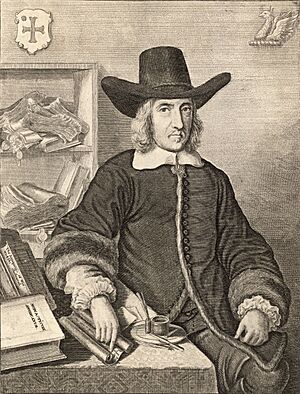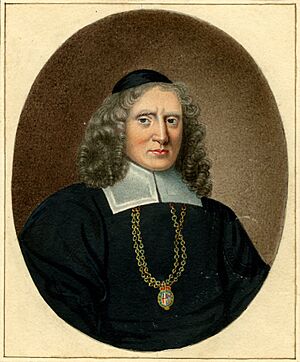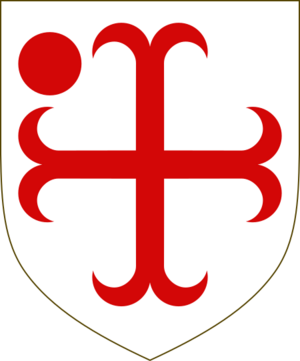William Dugdale facts for kids

Sir William Dugdale (born September 12, 1605 – died February 10, 1686) was an English historian who studied old things, known as an antiquary, and an expert in coats of arms, called a herald. He was very important in helping people learn more about the Middle Ages as a serious subject to study.
Contents
Early Life and Studies
William Dugdale was born in Shustoke, a village near Coleshill in Warwickshire. His father, John Dugdale, worked as a manager for a local landowner. When William was born, a group of bees flew into the garden. Some people thought this was a good sign for his future life.
He went to school at King Henry VIII School, Coventry in Coventry. In 1623, he married Margaret Huntbach. They had many children together. In 1625, after his father passed away, William bought a large house and land called Blyth Hall, close to Shustoke.
A few years later, he had a disagreement with a neighbor about land. During this time, he met William Burton, who was also an antiquary. William Dugdale started copying old documents and making notes about churches. He met other historians like Sir Simon Archer and Sir Thomas Habington.
He began working with Sir Simon Archer on a history of their home county, Warwickshire. Their research took them to London, where they looked through old official records. In London, he met other important people who shared his interest in history, including Sir Christopher Hatton. Sir Christopher became his main supporter and offered him a place to stay.
Working for the King
In 1638, thanks to his friends, William Dugdale was given a special job as a "pursuivant of arms" named Blanche Lyon Pursuivant. This meant he helped with ceremonies and keeping track of family histories and coats of arms. In 1639, he was promoted to a higher role called Rouge Croix Pursuivant. These jobs gave him a place to live at the College of Arms in London and an income, which allowed him to continue his research.
In 1641, Sir Christopher Hatton asked William Dugdale to draw detailed pictures of all the monuments in Westminster Abbey and other important churches in England. Sir Christopher was worried that these historical sites might be damaged during the upcoming English Civil War.

In June 1642, William Dugdale was called to join King Charles I in York. When the Civil War began, the King asked him to deliver messages to the castles of Banbury and Warwick, telling them to give up.
He saw the Battle of Edgehill and later returned to the battlefield to map it out. In November 1642, he arrived in Oxford with the King and was given a special degree from Oxford University. He worked for the King's government in Oxford, especially after Sir Christopher Hatton became a royal official. In 1644, the King made him Chester Herald.
During his free time in Oxford, he gathered information for his books at the Bodleian Library and other university libraries. This is when he met Elias Ashmole, who later became his son-in-law. After Oxford surrendered in 1646, Dugdale went back to Blyth Hall.
After the War and Later Life
William Dugdale started his history research again. He worked with Roger Dodsworth on a big book called Monasticon Anglicanum, which was published in 1655. The next year, he published his own book, Antiquities of Warwickshire. This book quickly became a famous example of how to write a history of a county. In this work, he was one of the first people to think about how important stone tools were, suggesting they were used by early Britons before they knew how to make tools from metal.
When the King was brought back to power in England (this was called the English Restoration), William Dugdale became the Norroy and Ulster King of Arms. This was a very important job in the College of Arms. In this role, he traveled to counties north of the Trent to check on family coats of arms and records.
In 1677, he was made a knight and given the highest heraldry job, Garter Principal King of Arms. He held this position until he died. In his final years, he wrote about his own life. He passed away peacefully in his chair at Blyth Hall in 1686, at the age of 80.
Important Books
Here are some of the important books Sir William Dugdale wrote:
- Monasticon Anglicanum (1655–1673): This book was originally in Latin and was later translated into English. It's about the history of monasteries in England.
- Antiquities of Warwickshire (1656): A detailed history of his home county.
- History of St Paul's Cathedral (1658): About the famous cathedral in London.
- The History of Imbanking and Drayning (1662): About how land was managed and drained for farming.
- Origines Juridiciales (1666): About the history of law.
- Baronage of England (1675–1676): About the noble families of England.
- A Short View of the Late Troubles (1681): His thoughts on the recent Civil War.
- Ancient Usage of Bearing Arms (1682): About the history and rules of coats of arms.
- Visitations of Derbyshire, Yorkshire, etc.: Records from his travels as a herald.
He also helped edit other books, adding his own notes and ideas. His own life story, diaries, and letters were put together and published in 1827.
Coat of Arms
His Legacy
The Dugdale Society, a group that publishes historical texts about Warwickshire, is named after William Dugdale.
See also
- College of Arms
- Dugdale baronets


